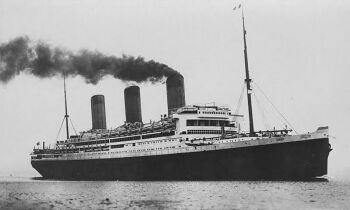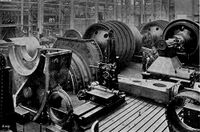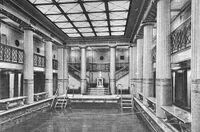RMS Imperatrice Rossa

| |
| History | |
|---|---|
| Name: | RMS Imperatrice Rossa |
| Namesake: | Legatus Atria Aurelia |
| Owner: |
|
| Port of registry: |
|
| Route: | Fumicino – Andria – Kenlis |
| Ordered: | 11 April 1900 |
| Builder: | Royal Shipbuilders of Cacerta, Fumicino, Cacertian Empire |
| Laid down: | 25 December 1900 |
| Launched: | 3 March 1903 |
| Completed: | 10 January 1904 |
| Maiden voyage: | 4 February 1904 |
| In service: | 4 February 1904 |
| Out of service: | 8 April 1940 |
| Fate: | Retired at Fumicino after 34 years of service. Sold for scrap, 15 August 1940. Superstructure and hull dismantled in Fumicino. |
| Status: | Scrapped |
| General characteristics | |
| Class and type: | Empress-class ocean liner |
| Displacement: | 56,551 tons |
| Length: | 291.4 meters |
| Beam: | 30.5 meters |
| Draught: | 11.2 meters |
| Decks: | 11 |
| Installed power: |
|
| Propulsion: |
|
| Speed: | 25 knots (46 km/h) max |
| Capacity: | 4,234 passengers |
| Crew: | 1,181 crew |
RMS Imperatrice Rossa (Italian: Red Empress) was a Cacertian ocean liner and the second ship of the White Star Line’s Empress-class ocean liners. The largest of three ships eventually constructed, the Imperatrice Rossa had a long career serving as a long-haul liner traveling from Fumicino to Andria to Kenlis. Her luxurious facilities and untarnished safety record gave the Imperatrice Rossa a famed reputation as a Cacertian liner. She would be requisitioned as a troopship late in her career during the Siduri War between 1934 and 1938.
She was laid up in Fumicino following the war and was originally intended to be refitted, refurbished, and put back into service. However, the growing prominence of airships and the introduction of more efficient fixed-wing aircraft made her a costly investment and, after projections reflected that her operation would be unprofitable, the plans to put her back into service were cancelled. She remained docked in Fumicino for a little over a year and a half before her ownership was transferred to the Royal Shipbuilders of Cacerta who scrapped her in 1940.
Background and Construction
As with most ships in Cacerta at the time, the Imperatrice Rossa was laid down and constructed by the Royal Ship Builders of Cacerta in Fumicino. All the ships of the Empress-class were intended to be the largest and most luxurious in the world, securing Cacerta’s domination of the Siduri market. Unlike her sister ships, however, Rossa also had a secondary purpose of also penetrating the Eracuran market of steam ocean liners that had long since been controlled by Ossorian companies. It was unlikely that White Star would be able to directly compete in Eracura, but it was hoped to help expand its industry.
Size and comfort were given priority on the Empress-class, but this was especially so aboard the Imperatrice Rossa which would eventually be over twenty meters longer and carry nearly 500 more passengers than her sister ships. It was understood that Cacertian liners could not compete with their Ossorian peers in terms of speed, so instead the designers at CNRC and executives of the White Star Line focused on a high level of luxury. Livia Maffucci, a Gylic-Cacertian architect who was famous for her design of luxury hotels, was called in to help design the ship interior.
Construction of the Imperatrice Rossa began approximately a month after the Imperatrice Bianca and, to accommodate the size of the ships, CNRC made extensive upgrades to their facilities. Her hull was completed in early March 1903 and she was launched without her superstructure. As the only dry-dock large enough to accommodate her was being occupied by her sister ship for fitting out, Imperatrice Rossa was instead towed to Paviolo to complete construction. She was finally completed in January 1904 and made her maiden voyage a month later.
Design
The Imperatrice Rossa was the largest ship of the White Star Fleet upon her completion, measuring in at 291.4 meters long, 30.5 meters wide at her widest point, and displacing approximately 56,551 tons. She was equipped with two masts and three funnels. The first two of her funnels were used to vent smoke produced by the boilers while the third funnel was used to ventilate the engine rooms.
She was propelled by a set of four four-bladed propellers powered by four screws driven by a quartet of direct-drive steam turbines. The port-center propeller shaft was drive by a high-pressure turbine which exhausted into an intermediate pressure turbine that drove the starboard-center shaft. Exhaust from the intermediate turbine would then be divided equally into a pair of low-pressure turbines for the outer shafts. Running at 180 rpm, the steam turbines aboard the Rossa were capable of producing 49,000 kW of energy. Steam was supplied by 48 water-tube boilers in four watertight compartments and had a heating surface of 20,000 m². Originally designed to burn coal, the Rossa was later converted to burn oil and would serve as the test platform for the White Star’s later ocean liners.
Like the other ships of the Empress-class, the Rossa had four steam-driven electrical generators that produced 400 kW of energy as well as two 30 kW back-up generators that served to power the ship during an emergency.
Given her longer length, Rossa possessed sixteen watertight bulkheads (instead of fifteen) which separated the hull of the ship in seventeen compartments. Each of these bulkheads were equipped with watertight doors that closed vertically and would seal off compartments in the event of an emergency. These doors could be activated locally or automatically from a switch in the bridge. In 1908, these bulkheads were extended to match the entire height of the hull following the sinking of the Stella del Nord to improve her safety.
The waterworks that were originally designed for the Bianca were expanded and improved upon for the Rossa and provided hot water to all parts of the vessel via its complex network of pipes and valves. The ship’s freshwater supply was taken aboard while in port, but the Rossa was capable of desalinizing water if needed. She also possessed a complex heating network that circulated warm air throughout the ship; first-class cabins were also fitted with electrical heaters.
She was also equipped with a new radiotelegraph service much like her sister ships. While the service could be used by passengers to send and receive telegrams, navigation messages, weather reports, and warnings took priority as per White Star Line’s communications practices. Her transmitter was originally capable of broadcasting over a radius of 560 km, but this was greatly improved during her 1908 refit which allowed her to transmit an additional 200 km further.
Passenger Facilities
The passenger facilities aboard the Rossa were designed to meet the highest standards of luxury across all three classes. The original plans of the ship indicated that it could accommodate 989 first-class passengers, 1,201 in-second class, and 2,044 in third-class for a total capacity of 4,234. She also had facilities to accommodate her large crew of nearly 1,200. Her interior design also differed from previous White Star Line vessels by basing it on the style of Garezzo's famed Hotel Mare di Diamante, with first-class cabins furnished in the new Cacertian Empire style inspired by Empress Elliana herself. A variety of styles were used to decorate the cabins and public areas of the ship; all these features were meant to convey the impression that passengers were inside a hotel rather than a ship.
The first-class facilities included a saltwater swimming pool, an exercise hall, an orgy hall, and a mixed-gender public bath which consisted of an electric bath, steam room, cool room, massage room, and hot room. The inclusion of the orgy hall was a unique addition to the Rossa. It was believed that the majority of the first-class passengers she would be servicing would be Cacertian and that it would be appropriate to include an area aboard the ship for which Cacertians would be free to practice the uniquely Cacertian cultural trait of free-love. Following her 1908 refit, the first-class facilities were expanded to also include a squash court and a shuffleboard court.
The common rooms for first-class passengers were also grand in scope. They included a lounge in the style of Vichenza Palace with an enormous reception room, a smoking room, and a reading and writing room. Among other amenities, there was an á la carte restaurant which was run by the famous Syaran chef Ljuben Stojanovski. Stojanovski would later resign from service during the Divide War—during which first-class passengers noted the reduction in quality. He would later return following the end of the war and with a negotiated increase in his salary. Along with the á la carte restaraunt, the Rossa also had a café decorated in the style of a Gylic sidewalk café and a waterside veranda café that offered tea and light refreshments with grand views of the ocean.
Third-class accommodations aboard the Rossa were better than most other ships of the time and reflected the improved standards which the White Star Line had adopted for long-haul voyages for lower-class travel. On most other passenger ships, third-class consisted of little more than open dormitories in the forward or aft ends of the vessels in which hundreds of people were confined, usually without proper food or waste facilities. White Star Line ships, instead, had small, but private and comfortable cabins capable of housing two, four, six, eight, and ten passengers.
Dining rooms and public gathering areas were also provided to third-class passengers; this was also supplemented by the addition of a smoking room and a reading room. While these facilities were not as opulent or luxurious as their first or second-class counterparts, they were certainly well above average for the time.
Common leisure facilities for all three classes included the library, a common fitness area, and a number of other general rooms located around the vessel. It was also common for passengers to socialize on the open deck, relaxing in deck chairs and wooden benches.
The Rossa’s designation as a Royal Mail Ship indicated that she carried mail under contract with the Cacertian Empire’s Royal Mail Service. 760 m³ of space was reserved for the storage of letters and parcels with the on-board Sea Post Office manned by five postal clerks.
Service History
Following her completion in January 1904, Imperatrice Rossa began her sea trials near Paviolo on 12 January in which her maneuverability, speed, and wireless telegraphy were tested; she completed her trials successfully and without incident. She then left Paviolo bound for Fumicino, her port of registration, on 23 January and arriving the morning of the next day. Her arrival was greeted with great enthusiasm as she was quickly becoming an icon to signify Cacerta’s mastery of the seas. In the lead up time to her maiden voyage, the crew went to great lengths to familiarize themselves with the ship and all her features.
Under the command of Captain Lucretia Venier, Rossa’s maiden voyage began on 4 February 1904 from Fumicino, calling at Paviolo the next day, and then reaching Andria three days later on 8 February. She departed on 11 February for the four-day crossing to Kenlis and arrived in Ossoria on the afternoon of 15 February. Senior Designer Olimpia Tiepolo was present for the voyage along with a number of other designers and engineers as part of the CNRC’s review council; their purpose was to take extensive notes of her crossings and spot any problems or areas of improvement.
As the largest of White Star’s new class of superliners, Rossa’s maiden voyage attracted significant region-wide attention from the press and public. At both Andria and Kenlis, she was opened up to the public and received well over 7,000 visitors in each city. Approximately 10,000 spectators gathered to watch her depart for her first return trip from Kenlis.
Between 1904 and 1908, the Rossa made slightly over 50 round-trip runs (107 total voyages) on her line between Fumicino, Andria, and Kenlis without incident making her one of the safest long-haul liners at the time.
Stella del Nord Disaster
The Imperatrice Rossa was en route to Kenlis from Andria and had been at sea for two days on the night of the disaster. Wireless operator Daniela Venneri was on duty in the ship’s radio room when she received the distress call from Stella del Nord and immediately informed Captain Lelia Cale. Although they were approximately 900 kilometers south of the Stella’s location, Cale calculated a new course and ordered the ship’s engines be set to full power to assist in the rescue.
Several hours later, when she was closing to within 100 kilometers of the Stella’s last known position, she received a message from the LPR Bradán Feasa which had received the survivors from the SCS Simple Truths in the aftermath of the sinking. Captain Mathúna explained that there was no reason for her to continue her course as it would also bring her into the same ice field and recommended the Imperatrice Rossa to make a wide berth on her approach to Kenlis.
Imperatrice Rossa entered Kenlis harbor on the evening of 3 May. An agreement was brokered between the Alberreno Line and White Star in which her originally planned itinerary which would return her to Andria and subsequently Fumicino would be cancelled. Instead, the Rossa would take any survivors originally bound for Moddra and Andria and ferry them to their originally intended destinations without charge.
Post-Stella del Nord Refit
On 11 July 1908, White Star withdrew Imperatrice Rossa from service and returned her to Fumicino for a proper refit incorporating lessons learned from the Stella del Nord disaster two months prior and significantly improve her safety. While the ratio of lifeboats to passengers aboard the Imperatrice Rossa was not nearly as disparate as aboard the Stella del Nord, an additional twenty lifeboats were added so that she could accommodate all passengers and crew in the event she was at maximum capacity.
In addition to the lifeboats, an inner watertight skin was constructed in the boiler and engine rooms which gave her a double-hull. All of her watertight bulkheads were extended to match the height of the entire hull; this addressed a glaring flaw aboard the Stella del Nord in which water spilled over the top of the ship’s bulkheads which resulted in flooding of the adjacent compartments. Improvements were also made to her ballast and bilge pumps. With these additional measures, Imperatrice Rossa could theoretically remain afloat even if the first six of her seventeen compartments were flooded.
Imperatrice Rossa returned to service in November 1908. After her refit, she continued to serve with distinction and an ongoing reputation of safety. Given her route would often bring her through the iceberg alley of the Malian Sea, it became unspoken practice to put the most senior White Star captains in charge of a very experienced crew. This practice would extend to her sister ships and would continue for the White Star's long-haul liners well into the modern era.
Cruise of the Stars
In 1922, the Rossa was contracted by Liona Davion—daughter of then White Star Line owner Veronica Davion—for her now famous pleasure cruise. Known as the Crociera delle Stelle, the Cruise of the Stars, Liona invited socialites from across the region to join her on the 10-day journey from Fumicino to Andria to Kenlis and then back to Fumicino after spending several days in the Ossorian capital. The idea of the cruise was a result of nearly a year’s worth of correspondence between Liona and prominent Alscian sex worker and madam Milena Živanović. The two had met in 1921 in Etra, not long after the end of the Divide War when Liona was observing the performance of the Imperatrice Bianca in the post-Divide War market.
Some of the prominent Cacertians who sailed on Cruise of the Stars were members of the five major houses of Cacerta which included erotic actress Alessandra Quintilian, artist Benino Rosso, and Lorenza Sarissita. Several Gylic, Tennaite and Syaran personalities also attended the cruise such as Tennaite Princess Vimla Kalanadhabhatla, ballerina Adela Stein, acrobat Vicken Zohrabyan, writer Dæse Şyna, erotic novelist Kavinmalar Numitha, famous Syaran cubist painter Yosif Momchilov Strashilov, Ossor-Gylic actress Olivia Dafi, Tennaite actress Vishanthi Navetha, and industrialist Luka Karandzhulov.
The purpose of the cruise was to promote the luxury of White Star Line ships as well as network and socialize, among others. Liona spared little expense on the cruise and went to great lengths to properly accommodate all the attendees, both those who were familiar with Cacertian culture and those who were not. The journey was characterized both by its opulence and luxury, but also by its debauchery. While the practice of free love and orgies were commonplace in Cacerta and Alscia, this was not so in most other countries of the time and thereby challenged the social norms of the 1920s.
The Cruise of the Stars was considered a major success by Liona who would host similar events aboard the Grigia and Bianca in 1924 and 1926. It became a biennial event that has continued to take place aboard White Star Line ships into the present day; the most recent Cruise of the Stars took place in October 2020 aboard the RMS Regina d’Oro and was attended by Queen Anelyn, former Gylian Prime Minister Toni Vallas, and Anelyn’s royal entourage.
Siduri War
In May 1934, while mid-transit from Andria to Fumicino, the Cacertian Admiralty requisitioned the Rossa to be used as a troopship. The Rossa arrived in Fumicino on 8 May 1934 and, after her passengers and cargo had been unloaded, was handed over to the Cacertian Royal Navy for repurposing. Stripped of her peacetime fittings and outfitted with a handful of 90 mm quick-firing guns, Rossa was converted to a troopship with a max carrying capacity of nearly 14,000 troops. In August 1934, the HMT Imperatrice Rossa departed Fumicino carrying some 11,000 infantry bound for Mansuriyyah to fight in the Western Theater.
Ferrying troops from the Empire to the Western Theater would become the Rossa’s main route during the conflict. She would often make direct trips from the home islands to Mansuriyyah, then sail to Andria where she would refuel before returning to the home islands for more troops. Her many visits to Padua and Viareggio carrying troops safely overseas and then back home after the war made her a favorite symbol for both cities. Several paintings of her in Viareggio were made and a large dance hall in Padua—Giardini Rossi—was also named in her honor.
During her four years of service in the war, Rossa sailed some 750,000 kilometers and ferried nearly 400,000 soldiers to and from ports on the western coast of Siduri. She mainly served under the command of Captain Erika Chinnici who recalled the ease of her service and the reliance of her construction.
Post-War Service and Retirement
After the end of the Siduri War, Imperatrice Rossa was handed back to White Star in March 1938 and underwent a rudimentary refit for passenger service. She was then contracted by the Cacertian government to transport war husbands, war brides, and their children back home to Cacertian territories. When she had completed the contract in July, she was taken out of service when her Board of Trade certificate was not renewed.
White Star kept her as part of the company’s roster of vessels afterward, intending to invest in giving the vessel a proper refit but it was deemed cost-prohibitive to bring her up to new safety standards. The company approached the Cacertian government, who briefly entertained the idea of a subsidy, but the war had exhausted the nation’s economy and investing in ocean liners was not considered a priority at the time. Unable to secure additional funding, White Star officially retired her in April 1940 thereby signaling the end of the Rossa’s operational life.
She remained moored in Fumicino until August 1940 when she was sold to the Royal Shipbuilders of Cacerta, the company that had constructed her. En route to the ship breaking yards, Rossa attracted crowds of sightseers numbering in the thousands to see her off and in response the crew fired several rockets in acknowledgment of her long service. The final shutdown of her engines took place 16 August and marked the end of an illustrious career of nearly five million kilometers and 500 voyages. Rossa carried 1.5 million people over 30 years of passenger service, a feat that has yet to be beaten by any other White Star Line ship to date.
Rossa’s dismantling took over a year to complete. Special care was taken in taking apart her interior as many third parties expressed interest in purchasing different parts of her for use in other projects.
Legacy
The ship’s bell is kept in the lobby of the Padova History Museum as the ship’s namesake, Atria Aurelia, was a princess and eventual first Legatus of the Sabrian Empire. Annually, for Victory Day, the bell is rung twice in honor of Cacerta’s servicemen and women.
Some of the furnishings from the Rossa were installed in the bar-restaurant complex called the Red Empress Lounge. Several sections are panelled with great quantities of richly carved Cacertian oak which came from the Rossa’s first class lounge. A neon sign made in 1937 that advertises the Imperatrice Rossa was hung above the entrance in conjunction with the ship’s original bow lettering.
A complete first class reading-writing room, with the original chandeliers and bookcases, was incorporated into a high-class suite of the Fidellis Hotel in Vichenza. It has become a popular booking for both Cacertian and foreign honeymooners looking to experience the opulence of the early 20th century.
The whole of a second class drawing room from the ship forms part of the interior of a private home overlooking the harbor in Padua. The original owner of the home, who had it constructed in 1942, had been a soldier of the Siduri War who had been taken to her theater aboard the Rossa during the conflict and later was returned by her as well. Since 1997, the home is now a museum commemorating the Rossa and her service.
The original model of the Imperatrice Rossa is displayed at the Fumicino Naval History Museum after a long stay on the now retired RMS Opale Contessa. Another large builder’s model, commissioned by White Star in 1966, is located in the reception area of White Star’s headquarters in Cesena.
Dæse Şyna's popular comic romance novella, Landicrocia, was heavily inspired by her experiences aboard the Rossa during the first Cruise of the Stars. Acclaimed for her light-hearted recountings of the debaucherous affairs that ocurred on board and sharp observation of the dynamics between participants, Landicrocia was considered an insightful peek into the cultures of Cacerta and Alscia, and is credited with establishing the literary device of "enlightenment through excess" in Gylian popular culture, seen in works like The Case of the Facts.
The historical novel Heart of Rossa by Syaran writer Boyana Stanislavova Radulova set in Fumicino in the 1900s includes accounts of the building of the Rossa and her sister ship Bianca. It features several historical characters involved in the designing and construction of the Empress-classes with the climax of two love stories concluding as the ship approaches Kenlis on her maiden voyage.
See Also
- RMS Imperatrice Bianca; the first ship of the Empress-class and the Rossa’s sister.
- RMS Imperatrice Grigia; the final ship of the Empress-class and another of the Rossa’s sisters.
- RMS Marchesa di Smeraldo; entering service in 1940 after the Siduri War, the Marchesa di Smeraldo took over the Rossa’s original service line from Fumicino to Andria to Kenlis.





